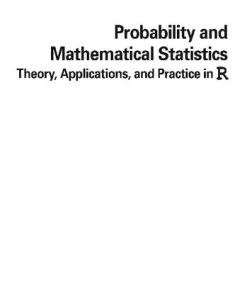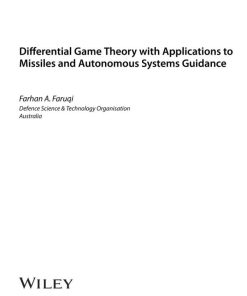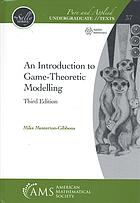Game-Theoretic Probability: Theory and Applications to Prediction, Science, and Finance 1st Edition by Glenn Shafer 1118548027 9781118548028
$50.00 Original price was: $50.00.$25.00Current price is: $25.00.
Game-Theoretic Probability: Theory and Applications to Prediction, Science, and Finance 1st Edition by Glenn Shafer – Ebook Instant Download/Delivery ISBN(s): 9781118548028, 1118548027

Product details:
- ISBN 10: 1118548027
- ISBN 13: 9781118548028
- Author: Glenn
Game-theoretic probability and finance come of age Glenn Shafer and Vladimir Vovk’s Probability and Finance, published in 2001, showed that perfect-information games can be used to define mathematical probability. Based on fifteen years of further research, Game-Theoretic Foundations for Probability and Finance presents a mature view of the foundational role game theory can play. Its account of probability theory opens the way to new methods of prediction and testing and makes many statistical methods more transparent and widely usable. Its contributions to finance theory include purely game-theoretic accounts of Ito’s stochastic calculus, the capital asset pricing model, the equity premium, and portfolio theory.
Table of contents:
Part I: Examples in Discrete Time
1 Borel’s Law of Large Numbers
1.1 A PROTOCOL FOR TESTING FORECASTS
1.2 A GAME‐THEORETIC GENERALIZATION OF BOREL’S THEOREM
1.3 BINARY OUTCOMES
1.4 SLACKENINGS AND SUPERMARTINGALES
1.5 CALIBRATION
1.6 THE COMPUTATION OF STRATEGIES
1.7 Exercises
1.8 CONTEXT
2 Bernoulli’s and De Moivre’s Theorems
2.1 Game‐Theoretic Expected value and Probability
2.2 Bernoulli’s Theorem for Bounded Forecasting
2.3 A Central Limit Theorem
2.4 Global Upper Expected Values for Bounded Forecasting
2.5 Exercises
2.6 Context
3 Some Basic Supermartingales
3.1 KOLMOGOROV’S MARTINGALE
3.2 DOL ANS’S SUPERMARTINGALE
3.3 HOEFFDING’S SUPERMARTINGALE
3.4 BERNSTEIN’S SUPERMARTINGALE
3.5 EXERCISES
3.6 CONTEXT
4 Kolmogorov’s Law of Large Numbers
4.1 STATING KOLMOGOROV’S LAW
4.2 SUPERMARTINGALE CONVERGENCE THEOREM
4.3 HOW SKEPTIC FORCES CONVERGENCE
4.4 HOW REALITY FORCES DIVERGENCE
4.5 FORCING GAMES
4.6 EXERCISES
4.7 CONTEXT
5 The Law of the Iterated Logarithm
5.1 VALIDITY OF THE ITERATED‐LOGARITHM BOUND
5.2 SHARPNESS OF THE ITERATED‐LOGARITHM BOUND
5.3 ADDITIONAL RECENT GAME‐THEORETIC RESULTS
5.4 CONNECTIONS WITH LARGE DEVIATION INEQUALITIES
5.5 EXERCISES
5.6 CONTEXT
Part II: Abstract Theory in Discrete Time
6 Betting on a Single Outcome
6.1 Upper and Lower Expectations
6.2 Upper and Lower Probabilities
6.3 Upper Expectations with Smaller Domains
6.4 Offers
6.5 Dropping the Continuity Axiom
6.6 Exercises
6.7 Context
7 Abstract Testing Protocols
7.1 Terminology and Notation
7.2 Supermartingales
7.3 Global Upper Expected Values
7.4 Lindeberg’s Central Limit Theorem for Martingales
7.5 General Abstract Testing Protocols
7.6 Making the Results of Part I Abstract
7.7 Exercises
7.8 Context
8 Zero‐One Laws
8.1 LÉvy’s Zero‐One Law
8.2 Global Upper Expectation
8.3 Global Upper and Lower Probabilities
8.4 Global Expected Values and Probabilities
8.5 Other Zero‐One Laws
8.6 Exercises
8.7 Context
9 Relation to Measure‐Theoretic Probability
9.1 VILLE’S THEOREM
9.2 MEASURE‐THEORETIC REPRESENTATION OF UPPER EXPECTATIONS
9.3 EMBEDDING GAME‐THEORETIC MARTINGALES IN PROBABILITY SPACES
9.4 EXERCISES
9.5 CONTEXT
Part III: Applications in Discrete Time
10 Using Testing Protocols in Science and Technology
10.1 SIGNALS IN OPEN PROTOCOLS
10.2 COURNOT’S PRINCIPLE
10.3 DALTONISM
10.4 LEAST SQUARES
10.5 PARAMETRIC STATISTICS WITH SIGNALS
10.6 QUANTUM MECHANICS
10.7 JEFFREYS’S LAW
10.8 EXERCISES
10.9 Context
11 Calibrating Lookbacks and p‐Values
11.1 LOOKBACK CALIBRATORS
11.2 LOOKBACK PROTOCOLS
11.3 LOOKBACK COMPROMISES
11.4 LOOKBACKS IN FINANCIAL MARKETS
11.5 CALIBRATING p‐VALUES
11.6 EXERCISES
11.7 CONTEXT
12 Defensive Forecasting
12.1 DEFEATING STRATEGIES FOR SKEPTIC
12.2 CALIBRATED FORECASTS
12.3 PROVING THE CALIBRATION THEOREMS
12.4 USING CALIBRATED FORECASTS FOR DECISION MAKING
12.5 PROVING THE DECISION THEOREMS
12.6 FROM THEORY TO ALGORITHM
12.7 DISCONTINUOUS STRATEGIES FOR SKEPTIC
12.8 Exercises
12.9 CONTEXT
Part IV: Game‐Theoretic Finance
13 Emergence of Randomness in Idealized Financial Markets
13.1 CAPITAL PROCESSES AND INSTANT ENFORCEMENT
13.2 EMERGENCE OF BROWNIAN RANDOMNESS
13.3 EMERGENCE OF BROWNIAN EXPECTATION
13.4 APPLICATIONS OF DUBINS–SCHWARZ
13.5 GETTING RICH QUICK WITH THE AXIOM OF CHOICE
13.6 Exercises
13.7 CONTEXT
14 A Game‐Theoretic It Calculus
14.1 Martingale Spaces
14.2 Conservatism of Continuous Martingales
14.3 It Integration
14.4 Covariation and Quadratic Variation
14.5 It’s Formula
14.6 DOLÉANS EXPONENTIAL AND LOGARITHM
14.7 GAME‐THEORETIC EXPECTATION AND PROBABILITY
14.8 Game‐Theoretic Dubins–Schwarz Theorem
14.9 Coherence
14.10 Exercises
14.11 Context
15 Numeraires in Market Spaces
15.1 MARKET SPACES
15.2 MARTINGALE THEORY IN MARKET SPACES
15.3 GIRSANOV’S THEOREM
15.4 EXERCISES
15.5 CONTEXT
16 Equity Premium and CAPM
16.1 Three Fundamental Continuous I‐Martingales
16.2 Equity Premium
16.3 Capital Asset Pricing Model
16.4 Theoretical Performance Deficit
16.5 Sharpe Ratio
16.6 Exercises
16.7 Context
17 Game‐Theoretic Portfolio Theory
17.1 STROOCK–VARADHAN MARTINGALES
17.2 BOOSTING STROOCK–VARADHAN MARTINGALES
17.3 OUTPERFORMING THE MARKET WITH DUBINS–SCHWARZ
17.4 JEFFREYS’S LAW IN FINANCE
17.5 EXERCISES
17.6 CONTEXT
People also search:
game of chance probability examples
games of chance and probability
game theory probability calculator
game-theoretic model
game theory and probability
You may also like…
Mathematics - Mathematical Statistics
Mathematics - Game Theory
Game Theory and Its Applications to Takeovers 1st Edition Suresh Deman
Science (General)
Cookbooks
Mathematics - Probability
Probability and statistics with reliability queueing and computer science applications Trivedi
Politics & Philosophy - Anthropology












